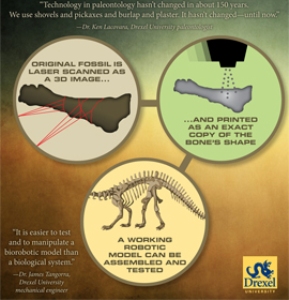Drexel University researchers are using next-generation technologies in three-dimensional printing for studying ancient life. For the first time, scale models of real fossils will be used in order to test hypotheses about how prehistoric animals and dinosaurs lived and moved during their time.
 Infographic: 3D Printed Robotic Dinosaurs
Infographic: 3D Printed Robotic Dinosaurs
Lacovara creates three-dimensional scans of huge dinosaur bones and other fossils in his laboratory. The scan helps in obtaining a virtual image in a digital work area that can be manipulated and analyzed by researchers. In order to bring life into these scans, Lacovara has joined hands with mechanical engineer and assistant professor in Drexel’s College of Engineering, to utilize 3-D printing technology for creation and testing of scale models of fossil bones.
A 3-D printer is a technology that helps quick prototyping and manufacturing objects based on a digital design. Common models work by extruding highly thin layers of a resin or other material, thus forming strata that will result in a physical object.
It is possible to print a 6” model of a dinosaur bone in just a few hours with the use of present technology.
The advantages of 3-D printing in the study of paleontology are:
- Creation of exact-size replicas for museum display, without limiting the number of copies made
- Creation of small-scale models to be used in education
- Creation of small-scale models for modeling and verifying beliefs about the behaviour of long-extinct animals
Tangorra and Lacovara will team up to create robotic models of giant sauropod dinosaurs by attaching tendons and artificial muscles to conduct detailed tests of how the animal’s body may have combated physical challenges of the environment.
Lacovara hopes that they will complete a working robotic dinosaur limb by the end of 2012. A full robotic dinosaur replica will take one to two years to create.